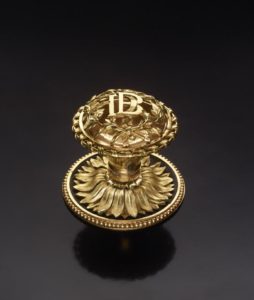We talk with Charlotte Vignon, Curator of Decorative Arts of The Frick Collection

Knob for a French window
Pierre Gouthière after a design by Claude-Nicolas Ledoux
Gilt bronze, ca. 1770
Knob: 2 × 2¼ inches Back plate: 2¾ × ⅜ inches
Musée des Arts décoratifs, Paris; photo: © Th. Hennocque
The Frick Collection presents the first exhibition on Pierre Gouthière (1732–1813), the great French bronze chaser and gilder who worked for Louis XV and Louis XVI. The exhibition sheds new light on the artist’s production, life, and workshop through the presentation of twenty-one objects from public and private collections. Attributed with certainty to Gouthière, these works include clocks, vases, firedogs, wall lights, and mounts for Chinese porcelain and hardstone vases. Here, we talk with Charlotte Vignon, Curator of Decorative Arts, The Frick Collection. Based on new art historical and technical research, the exhibition and catalogue promise to transform our understanding of one of the greatest artists of eighteenth-century France.
What gave you the idea for the show?
The initial idea for the show came from the remarkable blue turquin marble and gilt-bronze side table that we have here at the Frick, one of the highlights of the museum’s decorative arts holdings, which became the start of a fresh study of Gouthière, and soon sparked the idea for the show.
I know it took you five years to create this amazing exhibition, why so long?
Since the eighteenth century, Pierre Gouthière’s name has been associated with the most highly regarded gilt-bronze creations of French decorative art. This quickly fostered a keen interest in collecting his work during the nineteenth century, especially in Britain, and his name soon became associated with many of the art market’s best French eighteenth-century gilt-bronze creations. As a result, he has long suffered from dubious attributions.
Even Jacques Robiquet, who was the first to carry out an extensive study on the man in 1912—and despite criticizing unfounded attributions himself—made the same mistake! He did a remarkable study on the life of the man, but unfortunately, his catalogue raisonné is not very accurate. So you have to imagine that museums and private collections around the world—in London, Paris, New York, San Francisco—house countless French objects in gilt bronze, many of which may be traditionally attributed to Gouthière, but far fewer of which turn out to have any firm and convincing evidence for that attribution.
Joe Godla, Chief Conservator here at the Frick, and myself, hence had to visit all these worldwide collections to determine which objects really can be attributed with certainty to Gouthière. Three factors were taken into account for this attribution method: the description of the object in a contemporary archival document, in association with Gouthière’s name, particularly in inventories or invoices; a careful study of the provenance of the object; finally, a minute analysis of the gilt bronze itself. All of this takes time: we have now defined a corpus of 49 objects that are attributed with certainty to Pierre Gouthière, all of which figure in the publication. This gives a strong basis for further study and attributions in the future.
What new historical and technical finds to his process did you uncover?
Joe Godla’s study on Gouthière’s chasing and gilding techniques allows us to have a much better understanding of his process in making gilt-bronze pieces. We knew that Gouthière was credited with the invention of an innovative matte gilding method, as early as 1810, and thanks to Joe’s essay and our study of the gilt bronzes we attributed to Gouthière, we now know he mastered this technique as early as 1764, as evidenced by the vase and two incense burners made at that time, now in the Royal Castle, Warsaw, and included in the show at the Frick.
Gouthière’s matte gilding technique involved using a mixture of saltpeter, sea salt, and alum in water, which was applied in liquid form, using a brush, directly to parts of the object which were to be matte gilded. The piece was heated in the fire until the mixture became homogeneous, almost transparent, and then immediately plunged into clear water to remove the layer of salt. The result was a characteristic soft matte hue, which was so sought after by aristocratic patrons of the eighteenth century. Gouthière was the first to discover a successful way to obtain matte gilding for gilt bronze, as oppose to solid gold.
A full explanation of the complex process of casting, chasing and gilding an object in gilt bronze is explained in an educational video we made, which you can see in the exhibition as well as on our website here.
The show travels to Paris then what happens with these objects?
They return to the lenders; museums, and private collectors. Of course, we are hoping that the exhibition will engender a much greater recognition of Gouthière’s talents, and hence fuel research and interest, and hopefully new finds.
The Knob for a French window, Gouthiere is a famous gilder by the time he creates this why was this process so groundbreaking?
As I mentioned above, Gouthière was the first to invent matte gilding applied to gilt brass (commonly referred to as gilt bronze) as oppose to solid gold. When you look at an object such as this one (the knob) you can see how he is groundbreaking: his mastery of the gilding, alternatively matte and burnished (shiny), and the extremely refined and naturalistic chasing of leaves, ribbons and the interlaced D and B of Du Barry, mistress of Louis XV, give the object qualities that are close to those of a piece of jewelry. In fact, Elizabeth Vigée Le Brun, who wrote her Souvenirs in the 1830s, described the pavilion of Louveciennes, belonging to Du Barry and for which this knob was made for, as a place where “even the locks could be admired as masterpieces of the goldsmith’s art.”
What are your favorite objects in the show and why?
This is a difficult question! Perhaps the pair of ewers, ca. 1785, which belonged to Marie-Antoinette (now in a private collection) made with Chinese porcelain in a unique aubergine color, almost impossible to capture through photography backgrounds. The shape of the porcelain, the originality of the mounts, their sophistication—with so many matte gilded, intricate ornaments—, as well as the size of these objects, makes them really stunning pieces. The side table is another incredible object, made for the duchess of Mazarin’s townhouse in Paris. It was recently cleaned and restored, and is made from a beautiful and rare North African blue marble, with as many as 300 different molded gilt-bronze elements. It is a real masterpiece that the Frick is proud to own. Originally it would have been displayed in the same “grand-salon” as the five-branch poppy wall lights, also in the exhibition (on loan from the Louvre). Almost every flower of these lights is different from the others; they are breathtakingly naturalistic.
Why have so few people heard of this artist?
Gouthière’s reputation never faded from collectors’ and specialists’ circles; however, he is not known to a broader public. This is probably because he was neither a painter nor a sculptor but rather a chaser and a gilder. The “minor arts†have traditionally suffered from academic studies and a few exhibitions have been organized on craftsmen/artists. The aim of the exhibition is to show the general public how extraordinary Gouthière’s works are, as well as the complex process that went into making them. I personally think that a better understanding of his technique and his relationship with architects (who provided him with extraordinary designs) can only help deepen appreciation for these pieces.
The Frick Collection is one of the most special places on the planet, what do you think makes it unique?
The Frick is unique in that it is one of the last remaining city mansions from New York’s gilded age, that has been preserved intact, both the architectural frame, and the collections and furnishings that go with it. We keep the atmosphere of a house by displaying objects without protective cases and without chronology. It is a small paradise in an otherwise densely urbanized Manhattan. For this reason, New Yorkers and foreign visitors have made it one of their favorite spots, quite understandably!
The exhibition Pierre Gouthière: Virtuoso Gilder at the French Court is on display November 16, 2016 to February 19, 2017 at the Frick Collection.


